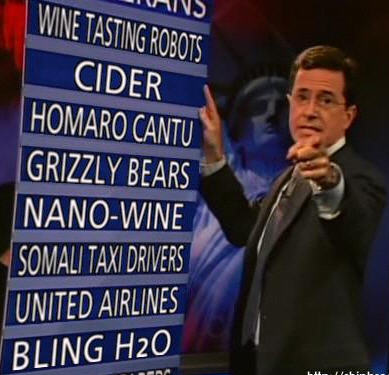Dr Vino's wine blog
wine talk that goes down easy
Competition, global warming, foire aux vins, Brunello — sipped and spit
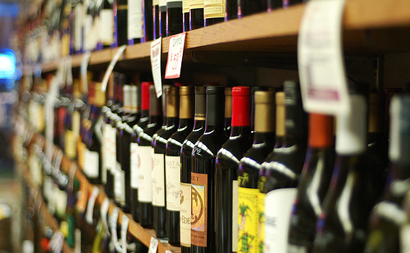
SIPPED: Competition!
Academic researchers Alan Wiseman and Jerry Ellig studied wine retail prices in Virginia before and after the Supreme Court decision. Care to guess which period had the higher prices? Indeed, prices fell 26 – 40 percent with greater interstate trade in wine. [Journal of Politics, pdf]
SIPPED and SPIT: wine discounts in France
The annual “foires aux vins” are taking place in hypermarkets around France. Consumers rejoice when markups can fall to as low as zero – five percent. Meanwhile, those in the trade grumble about other retailers scooping up the fine wine and reselling it for more later. In all, a quarter of French wine sells during these Foires according to the AFP story.
SIPPED: Pinot Noir. Go Ca-na-da!
The quest for North American pinot noir has moved north–1,100 miles north of Sonoma’s Russian River Valley to British Columbia. Hotter summers and milder winters have brought better grapes such as pinot noir to places like the Okanagan Valley, half way between Calgary and Vancouver. Now it’s a race against the frost to harvest. [WSJ]
SIPPED: late sampling
The 100 wines available by the glass at Artisanal will be half-priced after 10 PM. Starts next week. [Grub Street]
SPIT: Brunello di wha?!?
Author of historical fiction, Ken Follett, has a new 1,000+ page doorstop out. Let’s hope he gets his wine references right this time (we’re all up on our 14th century English wine, right?) since he admits that he erroneously invented the “Brunello Di Moltepulciano” in his last book.
SPIT: Claridges in London
The next time they go to London (by sailboat?), Treehugger admits a boycott of the Claridges hotel in London. Why? Because of the carbon footprint of the bottled water, now with over 30 choices including a liter from NZ for £50. Claridges’ Renaud Gregoire told the Evening Standard that “water is becoming like wine. Every guest has an opinion, and asks for a particular brand.” What the heck, given my earlier bottled water ban, I think I’ll boycott Claridges too! Feel the pain of my non-visit, Claridges! [Treehugger]
With a theme of Portuguese table wines, WBW 38 has been wrapped up with 30 contributors around the web. Great map! [Catavino]
Have you ever had a question for me? Hit the “contact” button above! Tom Wark had twenty questions for me that I answered in a Q&A. Check out my answers at his blog. [Fermentation]
(image)
Who’s threatening us now: BlingH20!!

Keen readers of this site know my antipathy–nay hostility–for bottled water. I gave up the easily substitutable beverage for thirty days to offset my wine carbon footprint, allowing me to enjoy wine from all corners of the earth with a clearer conscience.
Now we wine drinkers can focus our animosity at BlingH2O. This new product apes wine by calling itself the “Cristal” of bottled water, is sold in glass bottles with wine-like sizing, a cork, and for a wine-like price of $20 a pop–and a 375ml pop at that! (The water is “bottled at the source in Dandridge, Tennessee.”)
BlingH2o, you and your Swarovski crystal-encrusted, frosted glass bottle, you’re on notice!!!
Related: blingh2o.com
More “On notice“
The carbon footprint of wine
I recently tasted the intense, fruit-forward Tikal, Amorio, 2005 (about $30; find this wine). Along with notes of dark berries, tobacco and toast, was there also a whiff of petroleum?
The wine’s oversized bottle complemented the flavor profile perfectly since the bottle weighed about as much empty as a regular bottle full. I pity the wine store clerk who has to lift a case of it.
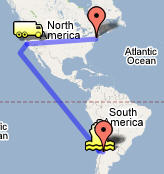 The heavy bottle took a long, meandering route to get to me in New York City. Starting out at the winery in Mendoza, Argentina, the wine’s American importer trucked it over the Andes to the port of San Antonio in Chile. There it loaded a boat and went to Oakland, CA. From there it came across country by truck to me in New York.
The heavy bottle took a long, meandering route to get to me in New York City. Starting out at the winery in Mendoza, Argentina, the wine’s American importer trucked it over the Andes to the port of San Antonio in Chile. There it loaded a boat and went to Oakland, CA. From there it came across country by truck to me in New York.
That’s a lot of carbon used to bring me this bottle of vino. But is it too much? At least the heavy bottle didn’t come by plane, which would have really jacked the petroleum per ounce of wine.
I was intrigued to read in the SF Chronicle that several restaurants have stopped serving (imported) bottled water because it is deemed too carbon inefficient.
Michael Pollan’s The Omnivore’s Dilemma prompted many eaters to think about the “carbon footprint” of their food and consider locally produced foods. Does that translate for you to your wine consumption?
The key issue for me is ease of substitution. I may be able to get water from local sources, but I can’t get any malbec locally. A tough call. Perhaps any eco guilt could be assuaged by buying carbon offsets?
Related:
“Local tap water bubbles up in restaurants” [SF Chronicle]
“Carbon neutral is hip, but is it green?” [NYT]
Mixing it up: your cocktail questions answered
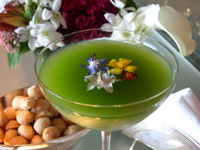
Brian Van Flandern recently answered my cocktail questions. Now he’s back and responds to yours.
Anonymous asked:
Has there ever been a decent cocktail made with still wine?
Brian:
Absolutely. There are many great cocktails that use wine as an ingredient. I myself have created several recipes that are greatly enhanced by the presence of wine. Sangria is made with wine and brandy for example. Try making a classic mojito (fresh lime juice, simple syrup, aged rum and Muddled mint) then add a modest splash of Pinot Noir. The result… a Burgundy Mojito. It tastes like a mojito up front with a pleasant slightly tannic sangria finish.
Kim asked:
How can I make my own Tonic Water?
Brian:
You stated that you are allergic to High Fructose Corn Syrup. This is not an uncommon allergy. I am NOT a doctor, so please make sure that you are not if fact allergic to quinine!
To make your own tonic, simply add a 16th of a tea-spoon of quinine powder to your base spirit (less is more) along with fresh lime juice and simple syrup. Shake this concoction vigorously WITHOUT ICE. The glycerin in the alcohol with dissolve the powder so that it does not clump or float on top.
Now fill a highball with ice and pour the mixture up to 50% full. Fill the rest of the glass with your favorite sparkling water. I use TyNant from Wales. It has smaller bubbles.
Finally, toss back and forth a couple of times and garnish with a lime. As always think ACID, ALCOHOL & SUGAR. Taste the drink and adjust it slightly by adding the component that will bring it into balance (i.e. add sugar if to tart, lime juice if to sweet, more gin if not enough booze, etc.) ENJOY!
Anne said:
Is a vodka – 7Up with two limes a balanced drink? If not what would you suggest is a good ratio for balance?
Brian:
Yes it is. There are many factors in determining ratio vs balance. Bottom line…Approximately 1 1/2 of alcohol, the juice of one lime and fill with 7-UP then TASTE. Follow the rules of balance (see KIM’s question) and you can’t go wrong. Remember…ACID, ALCOHOL & SUGAR. Balance, balance, balance.
SGSalerno said…
Thoughts on ice’s impact on cocktail making:
Ice is EXTREMELY important. The smaller the cubes the more dilution. It is GENERALLY desirable to have bigger cubes. Get the oversized ice cubes tray for home (like granny use to have). The quality of the water is also very important. Don’t fill up straight from the tap. Use filtered or bottled water. It makes a difference. There are applications for smaller cubes and crushed ice (the Mint Julip for example), however those are exceptions to the rules and are meant to be consumed quickly. Good luck.
If you have further question you may contact me at:
Brian Van Flandern
Creative Cocktail Consultants Corp.
www.MyMixologist.com
Veuve Clicquot tablets sparkle on the internets
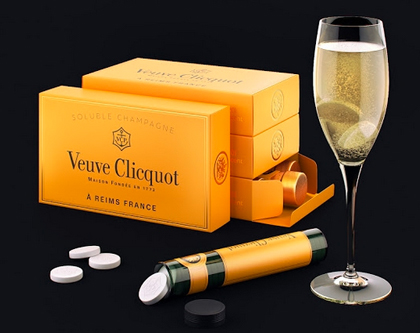
How would it sound if you could carry tablets of Veuve Clicquot in your handbag and drop then in water to make a glass of the famous bubbly? To those who drive popular brand to sales of over a half a million cases a year in the US, that sounds like their kind of “plop, plop, fizz, fizz.”
Photos of Veuve Clicquot tablets have surfaced on the internets today and some have latched on to the story as real. But it is actually a hoax, put out by a “Russian communication agency.” So there you have it. Apparently the muckety mucks at LVMH are none-too-happy about this. But given the legs the story has had, maybe it’s an idea they should explore commercially? Well, maybe some producer in another region will…
Talking PET, Paks, & pouches with Dave Pearce of Grove Mill
 Dave Pearce crunches carbon numbers for breakfast. The kiwi winemaker at Grove Mill winery has studied the carbon footprint of wine, reduced what emissions he can at his winery, and purchased offsets for the rest.
Dave Pearce crunches carbon numbers for breakfast. The kiwi winemaker at Grove Mill winery has studied the carbon footprint of wine, reduced what emissions he can at his winery, and purchased offsets for the rest.
We sat down over a macchiato in NYC one morning and discussed his views on alternative packaging. Although he recognizes the weight of glass and its role in the overall carbon footprint, his own wines still come in glass bottles. His thoughts, in brief: Read more…
Home field disadvantaged – NYT on SF wine lists
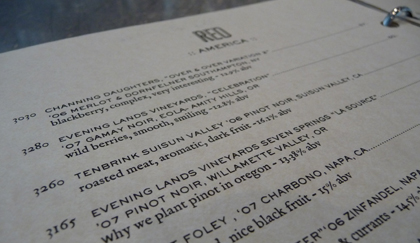
In a piece entitled, “Eat Local; Drink European,” Eric Asimov of the NYT tackles the apparent paradox at the core of some San Francisco restaurants: while the menus extol fresh local produce, the wine lists are often dominated by wines from Europe.
Why? One wine director, Chris Deegan of the restaurant Nopa, says “I find myself drinking European wines most of the time and pairing European wines more successfully with the food.” Mark Ellenbogen, wine director of a top Vietnamese restaurant, says, ““At Slanted Door, you need low-alcohol, high acid wines with residual sugar, and they don’t come from the New World.â€
Asimov continues the topic of the unwieldy pairings many American wines make with food over on The Pour. He writes, “the riper and riper styles of wine that have become popular in this country simply are not versatile with food, so restaurants look elsewhere.” He also notes some exceptions that he has found.
Wine style aside, I crunched some numbers for the piece based on my previous research on the carbon footprint of wine. Even though container shipping offers greater efficiency from a greenhouse gas perspective than trucking, a 9,500 mile sea journey still comes out higher than a 60 mile truck trip.
By way of an offset reminiscent of our bottle-for-bottle challenge, several restaurants in the Bay Area have discontinued serving water bottled in the Alps and now serve local, tap water, still or sparkling. And you can even try this at home.
Natural wines, premox, chenin blanc, 07 Port and Rhone – John Gilman
 John Gilman, author of the newsletter The View from the Cellar, joins us again for a Q&A. I asked him six questions; he replied with over 10,000 words! So grab a glass of wine, throw another log on the fire, grab a sandwich, channel your inner wine geek, and listen to John opine on the topics of natural wines, zero dosage champagne, some pitfalls of collecting, 2007 vintage for Port and in the Rhone, the nobility of chenin blanc, the Piedmont producer Produttori del Barbaresco and more!
John Gilman, author of the newsletter The View from the Cellar, joins us again for a Q&A. I asked him six questions; he replied with over 10,000 words! So grab a glass of wine, throw another log on the fire, grab a sandwich, channel your inner wine geek, and listen to John opine on the topics of natural wines, zero dosage champagne, some pitfalls of collecting, 2007 vintage for Port and in the Rhone, the nobility of chenin blanc, the Piedmont producer Produttori del Barbaresco and more!
Natural wines are growing in popularity. These include what might be termed “process controls” such as organic and biodynamic farming, favoring indigenous yeasts over commercial strains, as well as the rise of “no sulfur” wines. Are these wines forcibly better? Read more…
